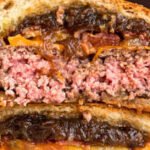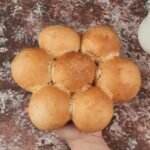Crumpets are a traditional British breakfast treat, known for their soft, spongy texture and their signature holes that form when cooked. They’re perfect for toasting, slathering with butter, and topping with jam, honey, or any of your favorite spreads. Making crumpets at home is easier than you might think, and the result is a fresh, homemade delight that will make your kitchen smell wonderful.
This recipe will walk you through the steps to create these delicious, spongy crumpets that are perfect for any breakfast or afternoon tea.
Ingredients:
- 2 cups (250g) all-purpose flour
- 1 teaspoon sugar
- 1 teaspoon salt
- 1 tablespoon instant yeast
- 1 1/4 cups (300ml) warm milk (about 110°F or 45°C)
- 1/2 cup (120ml) warm water
- 2 tablespoons butter, melted (plus extra for greasing and serving)
- 1/2 teaspoon baking powder
Instructions:
Step 1: Prepare the Yeast Mixture
- Mix Warm Milk and Water: In a small bowl or jug, combine the warm milk and warm water. Make sure the liquids are not too hot, as this can kill the yeast. The ideal temperature is around 110°F (45°C), which is just warm to the touch.
- Activate the Yeast: Sprinkle the yeast and sugar into the warm milk-water mixture and stir gently. Let it sit for about 5-10 minutes until the mixture becomes frothy. This means the yeast is activated and ready to use.
Step 2: Make the Crumpet Batter
- Mix Dry Ingredients: In a large mixing bowl, whisk together the flour, salt, and baking powder.
- Combine Wet and Dry Ingredients: Pour the activated yeast mixture and melted butter into the dry ingredients. Stir with a wooden spoon or spatula until you get a smooth batter. The batter should be thick but pourable. If it’s too thick, you can add a little more warm water, a tablespoon at a time, to reach the desired consistency.
- Let the Batter Rest: Cover the bowl with a clean kitchen towel or plastic wrap and let the batter rest for about 1 hour, or until it has doubled in size. This gives the yeast time to work and create bubbles that will form the characteristic holes in the crumpets.
Step 3: Cook the Crumpets
- Prepare the Pan: While the batter is resting, lightly grease a large non-stick skillet or frying pan with a little butter. You will also need crumpet rings (round metal molds) to shape the crumpets. If you don’t have crumpet rings, you can use egg rings, or simply cook the crumpets freeform.
- Heat the Pan: Place the pan over medium-low heat and let it warm up gently. The temperature should be moderate, not too hot, as crumpets cook best slowly to develop their characteristic texture.
- Grease the Crumpet Rings: Lightly grease the inside of the crumpet rings with butter or oil to prevent sticking.
- Fill the Rings: Once the pan is heated, place the crumpet rings in the skillet. Using a spoon or ladle, carefully pour the batter into the rings, filling them about halfway. You want the batter to rise and spread out during cooking.
- Cook the Crumpets: Let the crumpets cook for about 5-7 minutes, or until you see bubbles forming on the surface and the edges begin to set. Don’t move the rings while they’re cooking to maintain the shape.
- Flip or Not: Once the tops of the crumpets are set and the bubbles are visible, carefully remove the rings (use tongs or a fork). You can flip the crumpets over for an additional 1-2 minutes to cook the underside, but traditionally, crumpets are not flipped. Instead, they are served with the soft side up.
- Repeat: Continue this process with the remaining batter, making sure to grease the crumpet rings and the pan between batches.
Step 4: Serve the Crumpets
- Toast the Crumpets: While the crumpets are still warm, serve them with a generous spread of butter. The butter will melt into the crumpets, filling the holes with rich, creamy goodness. You can also add jam, honey, marmalade, or your favorite spread.
- Optional Garnish: For a special touch, sprinkle the crumpets with a bit of cinnamon sugar or top them with fresh fruit.
Tips and Variations:
- Texture: The key to a light, spongy texture is allowing the crumpet batter to rest for an hour and cooking them at a moderate temperature. If your pan is too hot, the crumpets will burn before the bubbles have a chance to form.
- Crumpet Rings: Crumpet rings are essential for shaping the crumpets. If you don’t have rings, you can use egg rings or improvise with a metal cookie cutter. Alternatively, you can cook them freeform, but the shape won’t be as uniform.
- Vegan Crumpets: To make vegan crumpets, simply substitute the butter for plant-based butter and use non-dairy milk (such as almond or oat milk) in place of the regular milk.
- Flavor Add-ins: You can add flavorings like cinnamon, nutmeg, or even dried fruit (like raisins or currants) to the batter for a twist on the classic crumpet recipe.
- Make Ahead: Crumpets are best eaten fresh, but you can make a large batch and freeze them for later. Just toast them when ready to eat, and they’ll be just as delicious!
Why Crumpets?
Crumpets are a nostalgic, comforting food that’s both soft and crunchy, with their characteristic holes that hold the butter and spreads. They are a perfect snack for breakfast, brunch, or afternoon tea. Their unique texture is the result of a slow cooking process that creates a delicate, airy crumb. Whether you enjoy them with butter, honey, jam, or even savory toppings like cheese and ham, crumpets are a versatile and delightful treat that will bring warmth and joy to any meal. Making them at home allows you to enjoy the freshest, fluffiest crumpets possible.
Enjoy your homemade crumpets fresh off the griddle, or toasted with your favorite topping.

Hayyat is a talented content writer and digital marketer with expertise in SEO, social media management, and online marketing. She excels at creating impactful, data-driven content to help businesses connect with their target audience and achieve measurable outcomes.



